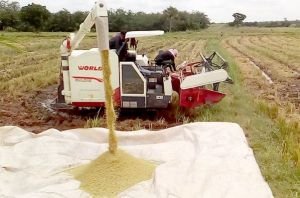
It has emerged that the Volta Region is the most efficient region in the management of farmland as far as rice cultivation in the country is concerned.
Farmers in the region harvest 5.1 metric tonnes of rice from cultivating 0.8 hectares of land. Conversely, farmers in the Northern Region account for 2.10 metric tonnes of rice per hectare.
This is, however, not peculiar to the Northern Region but is a characteristic of the rice-growing regions in the north of the country.
The Upper East and Upper West regions, for instance, produced 2.78 and 2.26 metric tonnes of rice per acre in the same period.
Even the Brong Ahafo Region which has now been divided into three regions was not spared this low output, as farmers averaged 1.75 metric tonnes per acre for all their efforts.
This finding was contained in an advocacy paper that was commissioned by the John Agyekum Kufuor Foundation.
According to the paper, though farmers in the Northern Region cultivate two hectares on average, they only harvest about 2.10 metric tonnes of rice per hectare.
This is second only to the Western Region, where farmers harvest 1.37 metric tonnes of rice per hectare.
The Greater Accra Region and the Eastern Region came up for positive mention, producing 4.82 and 4.02 hectares of rice per acre respectively.
The researchers found that due to the larger farm sizes, farmers in the Northern Region struggle to manage their farms after initial farm preparation, leading to lower yields.
The topography of farmlands in the Northern Region is, however, more favourable, as these are flatlands with fewer obstacles, meaning farm machinery face fewer impediments.
This is not the case in the Volta Region, where there is a mixture of undulating highland and lowlands as well as a mix of guinea savannah woodland and semi-deciduous forest.
The soil fertility and climate in the Volta Region are, however, more conducive to rice cultivation. The region also has access to more sources of water; conditions that are generally lacking in the northern sector.
The paper also found that poor land development of rice fields as a result of tree stumps, roots and debris are hindering the effective use of farm equipment.
There is also a dearth of mechanisation service providers and leasing companies. These, coupled with poor after-sales services from providers and poor access to spare parts, have hindered the mechanisation efforts in rice cultivation.
To tackle these issues, the paper recommended the use of such equipment as the skid shredders, mulchers and laser levelers for land development.
They also advised a closer collaboration with development partners to invest in the proper land development of lowlands and valley bottoms for rice production.
Furthermore, they recommended the building up of the capacity of bulldozer operators and contractors in proper land development for the production of rice.
By way of incentive, it was recommended that service providers who cater for smallholder farmers must be provided with some tax relief.
It was also recommended that import duty for local agents must be waived for local agents and spare parts dealers to enable them to set up satellite depots in farming communities.
The paper looked at data from 143 rice-growing districts in 10 regions in the country.
Source: The Finder
Leave a Reply